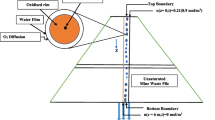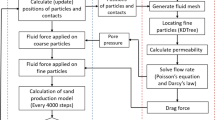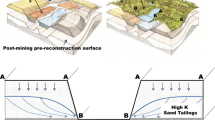Abstract
Spatial distribution of sand bodies in caprock is important to its sealing potential in the evaluation of a potential waste disposal site. A numerical investigation was conducted to investigate the roles of sand bodies in caprock integrity, and a new leaking mechanism associated with the embedded sand bodies has been identified for the first time. This numerical model is characterized by a low proportion of sand bodies in caprock formation and stochastic permeability assignments to the shale facies with a consideration of stress-sensitive permeability. The research revealed that sand bodies in caprock, even initially unconnected due to their low concentration, represent the foundation for creating a percolating flow path if certain conditions are met. These conditions include a relatively high pore pressure gradient across the caprock, which may occur during fluid injection and a favorable geometric configuration of these sand bodies. Sand bodies of different shapes play different roles in forming a percolating flow path. Sand bars/dykes can lead pore pressure front to cover a considerable vertical thickness quickly, while thin sand sheets tend to transfer the pore pressure front across a large horizontal range and thus increase the possibility of involving other local sand bodies in the evolution of percolating flow paths. On the other hand, the presence of percolating flow path in caprock can limit the pore pressure increase in the aquifer formation during fluid injection. The more active the flow paths, the less increase the pore pressure that occurs in the aquifer. Stress-dependent permeability can facilitate the formation of percolating flow path, but evaluating how much impact it may have remains a question for future research. The modeling results indicate that the underlying geologically based discrete structure of permeable domains, even when masked by a low-permeable rock matrix, exerts a significant influence on the location and magnitude of fluid flow within the system during fluid injection.














Similar content being viewed by others
References
Al-wardy W, Zimmerman RW (2004) Effective stress law for the permeability of clay-rich sandstones. J Geophys Res 109:B04203. doi:10.1029/20103JB002836
Anderson MP, Aiken JS, Web EK, Mickelson DM (1999) Sedimentology and hydrogeology of two braided stream deposits. Sediment Geol 129:187–199
Armitage PJ, Faulkner DR, Worden RH, Aplin AC, Butcher AR, Iliffe J (2011) Experimental measurement of, and controls on, permeability and permeability anisotropy of caprocks from the CO2 storage project at the Krechba Field, Algeria. J Geophys Res 116:B12208. doi:10.1029/2011JB008385
Bai M, Meng F, Elsworth D, Zaman M, Roegiers J-C (1997) Numerical modeling of stress dependent permeability. Int J Rock Mech Min Sci 34:3–4
Baines SJ, Worden RH (2004) Geological storage of carbon dioxide. In: Baines SJ, Worden RH (eds) Geological storage of carbon dioxide, vol 233. Geological Society, London, pp 1–6
Bauer S, Class H, Ebert M, Feeser V, Götze H, Holzheid A, Kolditz O, Rosenbaum S, Rabbel W, Schäfer D, Dahmke A (2012) Modeling, parameterization and evaluation of monitoring methods for CO2 storage in deep saline formations: the CO2-MoPa project. Environ Earth Sci 67:351–367
Begg SH, Williams JK (1991) Algorithms for generating and modeling sand-body distributions. In: Lake LW, Carrol HB, Wesson TC (eds) Reservoir characterization II. Academic Press, Cambridge, pp 613–639
Bianchi M, Zheng C, Wilson C, Tick GR, Liu G, Gorelick SM (2011) Spatial connectivity in a highly heterogeneous aquifer: from cores to preferential flow paths. Water Resour Res 47:W05524. doi:10.1029/2009WR008966
Bierkens MF (1996) Modeling hydraulic conductivity of a complex confining layer at various spatial scales. Water Resour Res 32(8):2369–2382
Boggs SJ (2001) Principles of sedimentology and stratigraphy. Prentice-Hall Inc, Upper Saddle River
Bouchard R, Delaytermoz A (2004) Integrated path towards geological storage. Energy 29:1339–1346
Bruderer-Weng C, Cowie P, Bernabe Y, Main I (2004) Relating flow channeling to tracer dispersion in heterogeneous networks. Adv Water Resour 27:843–855
Caers J (2003) Geostatistics: from pattern recognition to pattern reproduction. In: Nikravesh M, Aminzadeh F, Zadeh LA (eds) Developments in petroleum science, vol 51. Elsevier Science B.V, Amsterdam
Caers J (2005) Petroleum geostatistics. Society of Petroleum Engineers, Richardson
Chin LY, Raghavan R, Thomas LK (1998) Fully-coupled geo-mechanics and fluid flow analysis of wells with stress-dependent permeability. SPE J 5(1):48857
Costa A (2006) Permeability-porosity relationship: a reexamination of the Kozeny–Carman equation based on a fractal pore-space geometry assumption. Geophys Res Lett 33:L02318. doi:10.1029/2005GL025134
Daigle H, Screaton EJ (2014) Evolution of sediment permeability during burial and subduction. Geofluids. doi:10.1111/gfl.12090
Davies JP, Davies DK (2001) Stress-dependent permeability: characterization and modeling. SPE J 71750:224–235
De Lucia M, Bauer S, Beyer C, Kühn M, Nowak T, Pudlo D, Reitenbach T, Stadler S (2012) Modelling CO2-induced fluid–rock interactions in the Altensalzwedel gas reservoir. Part I: from experimental data to a reference geochemical model. Environ Earth Sci 67(2):563–572
de Marsily G, Delay F, Teles V, Schafmeister MT (1998) Some current methods to represent the heterogeneity of natural media in hydrogeology. Hydrogeol J 6(1):115–130
de Marsily G, Delay F, Goncalves J, Renard Ph, Teles V, Violette S (2005) Dealing with spatial heterogeneity. Hydrogeol J 13:161–183
Desbarats AJ (1987) Numerical estimation of effective permeability in sand-shale formations. Water Resour Res 23(2):273–286
Desbarats AJ, Hinton MJ, Logan CE, Sharpe DR (2001) Geostatistical mapping of leakance in a regional aquitard, Oak Ridges Moraine area, Ontario, Canada. Hydrogeol J 9:79–96
Downey MW (1984) Evaluating seals for hydrocarbon accumulation. AAPG Bull 68:1752–1763
Durlofsky LJ (1991) Numerical calculation of equivalent grid block permeability tensors for heterogeneous porous media. Water Resour Res 27(5):699
Durlofsky LJ (2003) Upscaling of geocellular models for reservoir flow simulation: a review of recent progress. Paper presented at 7th International Forum on Reservoir Simulation. Buhl/Baden-Baden, Germany, June 23–27
Edlmann K, Haszeldine S, McDermott C (2013) Experimental investigation into the sealing capability of naturally fractured shale caprocks to supercritical carbon dioxide flow. Environ Earth Sci 70:3393–3409
Fahrner S, Schafer D, Dethlefesen F, Dahmke A (2012) Reactive modelling of CO2 intrusion into freshwater aquifers: current requirements, approaches and limitations to account for temperature and pressure effects. Environ Earth Sci 67:2269–2283
Falivene O, Arbués P, Gardiner AR, Pickup GE, Muñoz JA, Cabrera L (2006) Best-practice stochastic facies modeling from a channel-fill turbidite sandstone analog (the Quarry Outcrop, Eocene Ainsa Basin, NE Spain). AAPG Bull 90:1003–1029
Fitts JP, Peters CA (2013) Caprock fracture dissolution and CO2 leakage. Rev Miner Geochem 77:459–479
Fogg GE (1986) Groundwater flow and sand body interconnectedness in a thick, multiple-aquifer system. Water Resour Res 22(5):679–694
Fogg GE, Noyes CD, Carle SF (1998) Geologically based model of heterogeneous hydraulic conductivity in an alluvial setting. Hydrogeol J 6(1):131–143
Freeze RA (1975) A stochastic-conceptual analysis of one-dimensional groundwater flow in non-uniform homogeneous media. Water Resour Res 11(5):725–741
Freeze RA, Cherry JA (1979) Groundwater. Prentice-Hall, Englewood Cliffs
Friedel T, Voigt H-D (2009) Analytical solutions for the radial flow equation with constant-rate and constant-pressure boundary conditions in reservoirs with pressure-sensitive permeability. SPE 122768 SPE Rocky Mountain Petroleum Technology Conference, 14–16 April, Denver, Colorado, USA
Gomez-Hernanez JJ, Sahuquillo A, Capilla JE (1997) Stochastic simulation of transmissivity fields conditional to both transmissivity and piezometric data—I. Theory. J Hydrol 203:162–174
Graham W, McLaughlin D (1989) Stochastic analysis of nonstationary subsurface solute transport, 1, unconditional moments. Water Resour Res 25(2):215–232
Grasby S, Osadetz K, Betcher R, Render F (2000) Reversal of the regional-scale flow system of the Williston basin in response to Pleistocene glaciations. Geology 28(7):635–638
Grunau HR (1981) Worldwide review of seals for major accumulations of natural gas. AAPG Bull 65:993
Grunau HR (1987) A worldwide look at the cap rock problem. J Pet Geol 10(3):245–266
Guven O, Molz FJ, Melville JG (1986) Comment on “an advection-diffusion concept for solute transport in heterogeneous unconsolidated geological deposits” by Gilham et al. Water Resour Res 22(1):89–91
Haldorsen HH, Chang DW (1986) Notes on stochastic shales: from outcrop to simulation model. In: Lake LW, Carrol HB (eds) Reservoir characterization. Academic Press, London, pp 445–485
Han G, Dusseault MB (2003) Description of fluid flow around a wellbore with stress-dependent porosity and permeability. J Petrol Sci Eng 40:1–16
Han WH, Kim K-Y, Choung S, Jeong J, Jung N-H, Park E (2014) Non-parametric simulations-based conditional stochastic predictions of geologic heterogeneities and leakage potentials for hypothetical CO2 sequestration sites. Environ Earth Sci 71:2739–2752
Hao S, Huang Z, Liu G, Zheng Y (2000) Geophysical properties of cap rocks in Qiongdongnan Basin, South China Sea. Mar Pet Geol 17:547–555
Haque NM, Bjørlykke K, Jahren J (2008) Experimental compaction of clays: relationship between permeability and petrophysical properties in mudstones. Pet Geosci 14:319–337
Hernandez-Marin M, Pacheco-Martinez J, Ramirez-Cortes A (2014) Evaluation and analysis of surface deformation in west Chapala basin, central Mexico. Environ Earth Sci 72:1491–1501
Hibbitt, Karlsson, Sorensen, Inc (1998) ABAQUS, Standard Users Manual. Hibbitt, Karlsson & Sorensen Inc., Pawtucket, Rhode Island
Hou Z, Rockhold ML, Murray CJ (2012) Evaluating the impact of caprock and reservoir properties on potential risk of CO2 leakage after injection. Environ Earth Sci 66(8):2403–2415
Jaeger JC, Cook NGW, Zimmerman RW (2007) Fundamentals of rock mechanics. Blackwell Publishing, Malden
Johnson NM, Dreiss SJ (1989) Hydrostratigraphic interpretation using indicator geostatistics. Water Resour Res 25(12):2501–2510
Katsube TJ, Williamson MA (1994) Effects of diagenesis on shale nanopore structure and implications for sealing capacity. Clay Miner 29:451–461
Katsuki D, Gutierrez M (2013) Poroelastic effects on the stress-dependent permeability of a stiff shale. In: Poromechanics V—Proceedings of the 5th biot conference on poromechanics, pp 1705–1714
Kharaka YK, Thordsen JJ, Kakouros E et al (2010) Changes in the chemistry of shallow groundwater related to the 2008 injection of CO2; at the ZERT field site, Bozeman, Montana. Environ Earth Sci 60:273–284
King PR (1990) The connectivity and conductivity of overlapping sand bodies. In: Buller AT, Berg E, Hjemeland O, Kleppe J, Torsaeter O, Aasen JO (eds) North Sea oil and gas reservoirs II. Graham and Trotham, London, pp 353–362
Knudby C, Carrera J (2005) On the relationship between indicators of geostatistical, flow and transport connectivity. Adv Water Resour 28:405–421
Kolditz O, Bauer S, Beyer C, Böttcher N, Dietrich P, Görke UJ, Kalbacher T, Park CH, Sauer U, Schütze C, Shao H, Singh A, Taron J, Wang W, Watanabe N (2012) A systematic benchmarking approach for geologic CO2 injection and storage. Environ Earth Sci 67:613–632
Koltermann CE, Gorelick SM (1996) Heterogeneity in sedimentary deposits: a review of structure-imitating, process-imitating, and descriptive approaches. Water Resour Res 32:2617–2658
Li Q, Wu Z, Lei X, Murakami Y, Satoh T (2007) Experimental and numerical study on the fracture of rocks during injection of CO2-saturated water. Environ geol 51(7):1157–1164
Li Q, Wu Z, Li X (2009) Prediction of CO2 leakage during sequestration into marine sedimentary strata. Energ Convers Manag 50(3):503–509
Magowe M, Carr J (1999) Relationship between lineaments and ground water occurrence in western Botswana. Ground Water 37(2):282–286
Matheron G, de Marsily G (1980) Is transport in porous media always diffusive? A counterexample. Water Resour Res 16(5):901–917
Mavko G, Mukerji T, Dvorkin J (1998) The rock physics handbook: tools for seismic analysis of porous media, 2nd edn. Cambridge University Press, Cambridge
Muskat M (1949) Physical principles of oil production. McGraw-Hill, New York
Olierook HKH, Piane CD, Timms NE, Esteban L, Rezaee R, Mory AJ, Hancock L (2014) Facies-based rock properties characterization for CO2 sequestration: GSWA Harvey 1 well, Western Australia. Mar Pet Geol 50:83–102
Park Y-C, Huh D-G, Park C-H (2012) A pressure-monitoring method to warn CO2 leakage in geological storage sites. Environ Earth Sci 67:425–433
Peng S, Zhang J (2007) Engineering geology for underground rocks. Chapter 8: stress-dependent permeability. Springer, Berlin, pp 199–220. ISBN 978-3-540-73294-5
Petit JC (1992) Reasoning by analogy: rational foundation of natural analogue studies. Appl Geochem 1:9–12
Pudlo D, Reitenbach V, Albrecht D, Ganzer L, Gernert U, Wienand J, Kohlhepp B, Gaupp R (2012) The impact of diagenetic fluid–rock reactions on Rotliegend sandstone composition and petrophysical properties (Altmark area, central Germany). Environ Earth Sci 67:369–384
RamaRao BS, LaVenue AM, de Marsily G, Marietta MG (1995) Pilot point methodology for automated calibration of an ensemble of conditionally simulated transmissivity fields 1. Theory and computational experiments. Water Resour Res 31(3):475–493
Rodrigo-Naharro J, Nisi B, Vaselli O, Lelli M, Saldana R, Clemente-Jul C, del Villar LP (2013) Diffuse soil CO2 flux to assess the reliability of CO2 storage in the Mazarron–Ganuelas Tertiary Basin (Spain). Fuel 114:162–171
Rutqvist J, Tsang CF (2002) A study of caprock hydromechanical changes associated with CO2-injection into a brine formation. Environ Geol 42:296–305
Rutqvist J, Birkholzer JT, Cappa F, Tsang C-F (2007) Estimating maximum sustainable injection pressure during geological sequestration of CO2 using coupled fluid flow and geo-mechanical fault slip analysis. Energy Convers Manag 48:1798–1807
Saripalli P, McGrail P (2002) Semi-analytical approaches to modelling deep well injection of CO2 for geological sequestration. Energy Convers Manag 43(2):185–198
Scheidegger AE (1974) The physics of flow through porous media, 3rd edn. University of Toronto Press, Toronto
Shukla R, Ranjith P, Haque A, Choi X (2010) A review of studies on CO2 sequestration and caprock integrity. Fuel 89(10):2651–2664
Smith J, Durucan S, Korre A, Shi J-Q (2011) Carbon dioxide storage risk assessment: analysis of caprock fracture network connectivity. Int J Greenh Gas Control 5:226–240
Teimoori A, Chen Z, Rahman S, Tran T (2005) Effective permeability calculation using boundary element method in naturally fractured reservoirs. Pet Sci Technol 23(5–6):693–709
Webb EK, Anderson MP (1990) Tracking contaminant pathways in sandy, heterogeneous, glacio-fluvial sediment using a sedimentary depositional model. In: Moltayaner G (ed) Transport and mass exchange in sand and gravel aquifers: field and modeling studies, vol 1. Atomic Energy of Canada Limited, Chalk River, pp 243–354
Webb EK, Anderson MP (1996) Simulation of preferential flow in three-dimensional heterogeneous conductivity fields with realistic internal architecture. Water Resour Res 32(3):533–545
Weissmann GS, Carle SF, Fogg GE (1999) Three-dimensional hydrofacies modeling based on soil surveys and transition probability geostatistics. Water Resour Res 35(6):1761–1770. doi:10.1029/1999WR900048
Wiese B, Zimmer M, Nowak M, Pellizzari L, Pilz P (2013) Well-based hydraulic and geochemical monitoring of the above zone of the CO2 reservoir at Ketzin, Germany. Environ Earth Sci 70:3709–3726
Yale DP, Crawford B (1998) Plasticity and permeability in carbonates: dependence on stress path and porosity. SPE/ISRM 47582. Presented at the SPE/ISRM Eurock’98 held in Trondheim, Norway, 8–10 July
Zeng Z, Jakupi A, Bigelow T, Grigg RB, Kringstad J, Belobraydic M, Zhou X (2008) Laboratory observation of CO2 phase transition induced seismic velocity change. Paper ARMA08-329. In: Proceedings of 42nd US Rock Mechanics and 2nd U.S.-Canada Rock Mechanics Symposium, San Francisco, California, USA, June 29–July 2
Zhou X, Burbey TJ (2014a) Fluid effect on hydraulic fracture propagation behavior: a comparison between water and supercritical CO2-like fluid. Geofluids 14(2):174–188
Zhou X, Burbey TJ (2014b) Pore-pressure response to sudden fault slip for three typical faulting regimes. Bull Seismol Soc Am 104(2):793–808
Zhou X, Zeng Z (2014) The development of stylolites in carbonate formation: implication for CO2 sequestration. Acta Geol Sin 88(1):238–247
Zhou Q, Birkholzer JT, Mehnert E, Lin YF, Zhang K (2009) Modeling basin-and plume-scale processes of CO2 storage for full-scale deployment. Ground Water 48(4):494–514
Zhou X, Zeng Z, Liu H (2010) Laboratory testing on Pierre shale for CO2 sequestration under clayey caprock. Paper ARMA10-107. In: Proceedings of 44th U.S. and 5th U.S.-Canada Rock Mechanics Symposium, Salt Lake City, UT, USA, June 27–30
Zhou X, Zeng Z, Liu H (2011) Stress-dependent permeability of carbonate rock and its implication to CO2 sequestration. ARMA11-135. In: Proceedings of 45th U.S. Rock Mechanics Symposium, San Francisco, CA, USA, June 26–29
Zhou X, Burbey TJ, Westman E (2015) The effect of caprock permeability on shear stress path at the aquifer–caprock interface during fluid injection. Int J Rock Mech Min Sci 77:1–10
Zhu L-F, Li M-L, Li C-L, Shang J-G, Chen G-L, Zhang B, Wang X-F (2013) Coupled modeling between geological structure fields and property parameter fields in 3D engineering geological space. Eng Geol 167(17):105–116
Acknowledgments
This technical effort was performed in support of the National Energy Technology Laboratory’s ongoing research in geologic CO2 sequestration under the RES contract DE-FE0004000. Any opinions, findings, and conclusions expressed in this material are those of the authors and do not necessarily state or reflect the views of the US Government or any agency thereof. We appreciate anonymous reviewers for providing very helpful comments to improve the quality of this paper.
Author information
Authors and Affiliations
Corresponding author
Rights and permissions
About this article
Cite this article
Zhou, X., Burbey, T.J. Numerical modeling of percolating flow path in a caprock formation during aquifer pressurization and its implication for CO2 sequestration. Environ Earth Sci 75, 861 (2016). https://doi.org/10.1007/s12665-016-5679-1
Received:
Accepted:
Published:
DOI: https://doi.org/10.1007/s12665-016-5679-1




